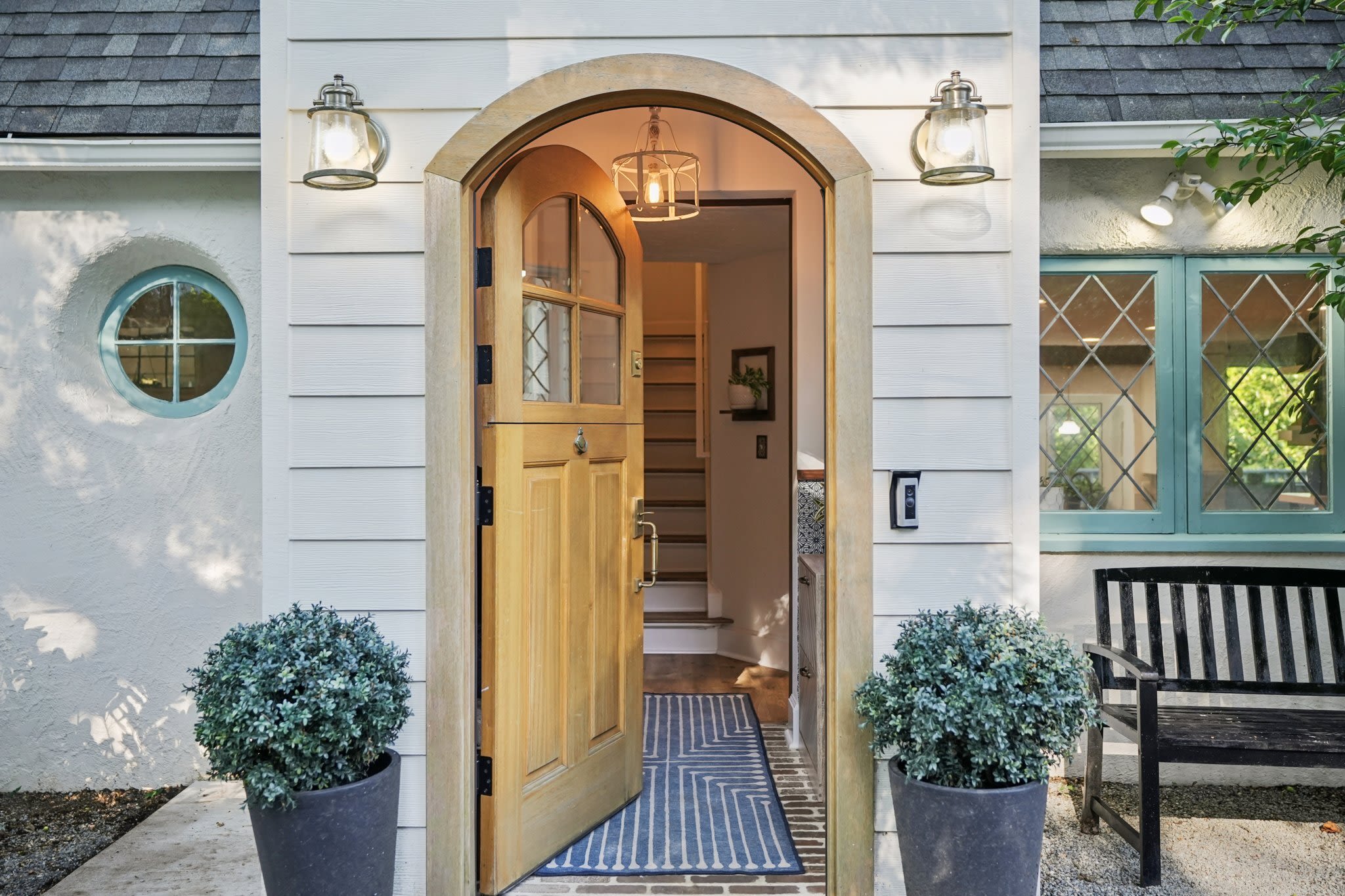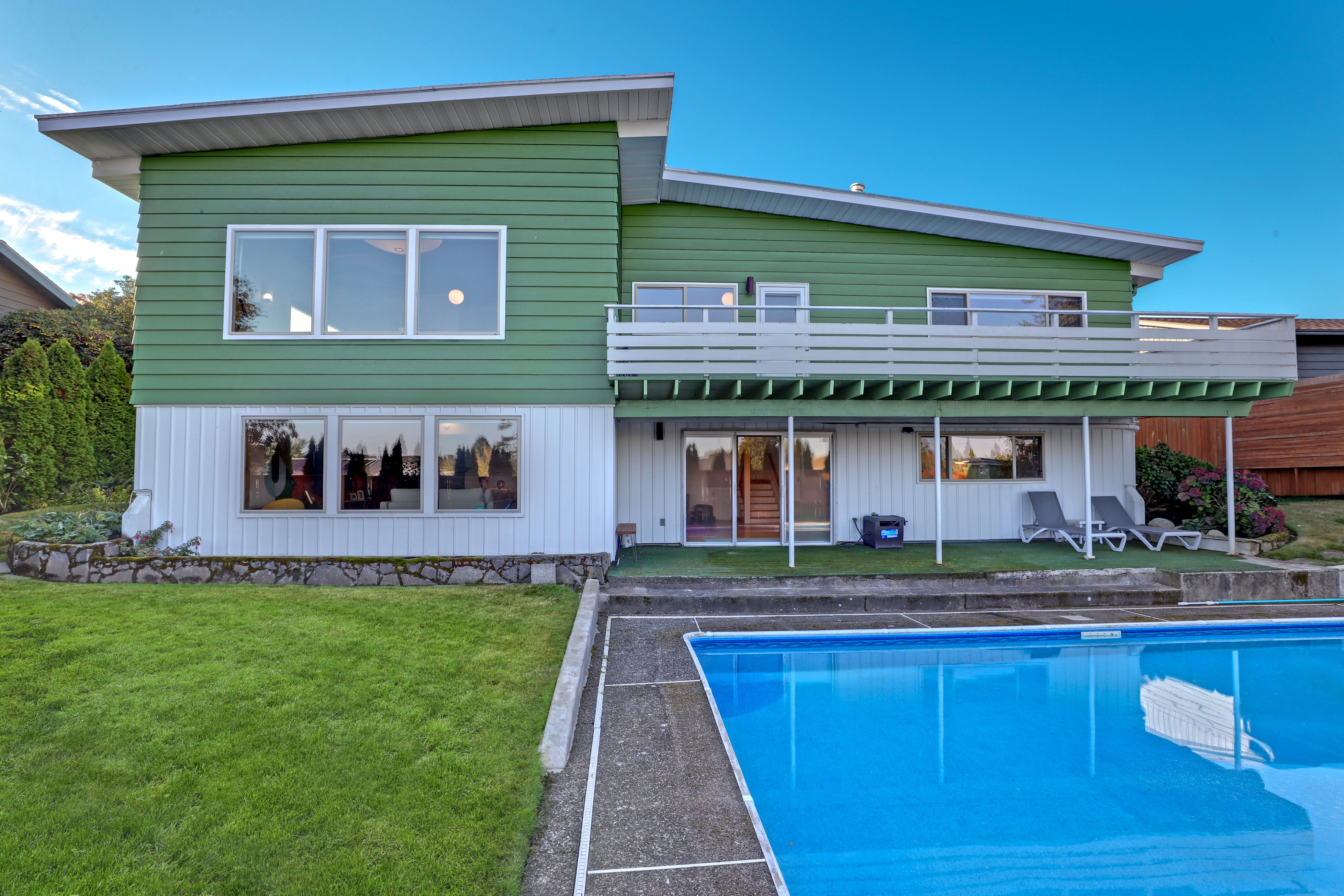Lake Escape
WHEN A FOR-SALE SIGN went up just down the street from Bob and Stevie Burke, the retired Lake Oswego couple knew they had finally found their dream home.
Well, sort of.
What attracted their attention wasn’t so much the house, a circa-1979 trilevel that was starting to show its age, as where it sat—on a lot that hugged the sloping south bank of the cozy suburb’s namesake. Not only did the home overlook the 405-acre lake’s glistening waters, but it also possessed an unobscured, east-facing view of the white-capped peak of Mount Hood. “The view was drop-dead gorgeous,” Stevie says.
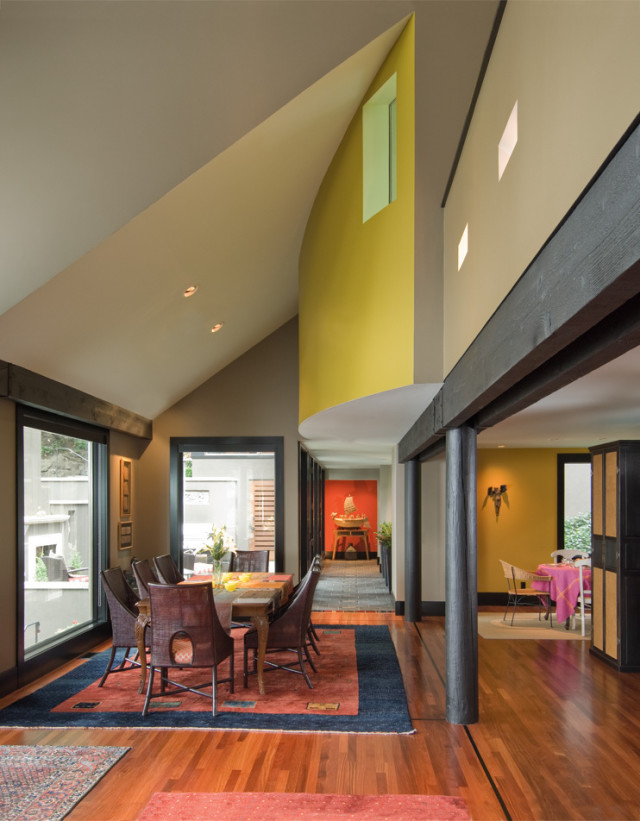
Heavy posts and beams are about all that’s left of the ’70s trilevel that architect Dennis Batke redesigned for the Burkes.
The Burkes had been offhandedly looking for a lakeside residence since 1997, a decade after they had settled into a contemporary four-bedroom home a few blocks inland from the shore. Bob, a fit 63-year-old who radiates a gracious calm, cofounded and led a successful investment firm in California before leaving the company 14 years ago to embark on a second career as a fourth-grade teacher. After a six-year stint with the Lake Oswego school district, he joined Stevie, also 63, a former interior designer with a bright smile and similarly easy manner, in full-time retirement.
As a result, the couple, who celebrated their 41st wedding anniversary in September, spend a considerable amount of time at home—that is, when they’re not traveling in Asia (they’ve visited Bhutan, Tibet, Mongolia and China together, and Bob recently returned from a stay at a Buddhist monastery in Kathmandu) or spending their winters in Palm Desert. The lot seemed to offer a perfect summertime retreat, providing not only a grand vista, but also privacy: Tall fir trees and a curve in the lake shore shielded the abode from the gaze of passing boaters, while a long driveway kept it completely hidden from the street.
When the Burkes took ownership of their dream property, however, they knew they’d have to radically transform the house. The woodsy ’70s style needed updating, and at 3,300 square feet, it was too small to accommodate the couple’s frequent houseguests and provide privacy for the hosts. The east perimeter wall needed more glass to really take advantage of the natural surrounds. Plus, there was the dreaded “grocery bag” problem. To get from the end of the driveway to the front door, one had to trundle down a plummeting flight of exterior stairs, a laborious journey for anyone, much less a couple in their 60s, to undertake while clutching jugs of milk.
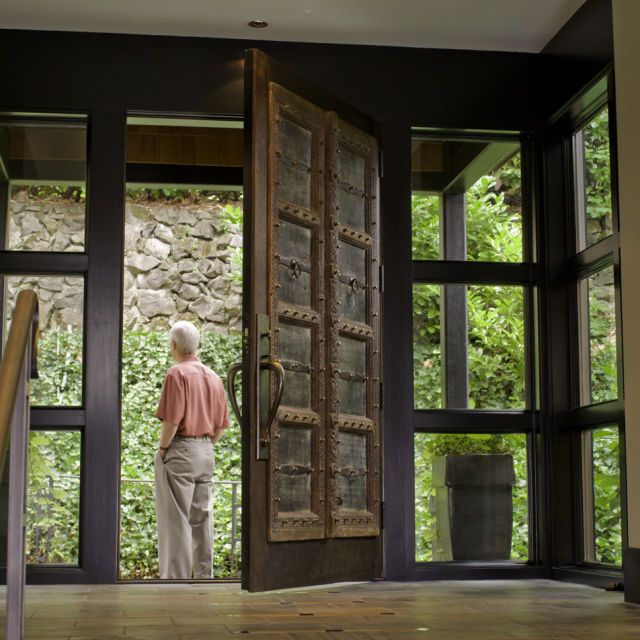
An antique panel from India finds new life, having been incorporated into the Burke’s front door.
Image: Jon Jensen
The Burkes hired Dennis Batke, a local architect with experience designing luxury homes and commercial spaces (including the iconic corrugated-metal-clad headquarters he remodeled for Tin House magazine on NW Thurman St at 26th) to completely rethink the house. It was an apt choice. His radical proposal called for expanding the floor plates on all four sides, building an elevator shaft between the driveway and the main level to dispense with the stair problem, and connecting the elevator to the main structure with interior corridors. Besides adding nearly 4,000 feet of living space, Batke incorporated an east-facing glass wall supported by a steel frame, which opened the home to the lake’s dramatic expanse. He even reduced the steep pitch of the roof to allow the glass wall to grow taller, so that the home’s mezzanine level could enjoy a wide-open shot of Mount Hood’s profile.
As a result of Batke’s redesign and the expert work of contractor Paul Steiner of Otis Construction, which specializes in high-end residential remodels, the Burkes occupy what’s essentially a brand-new house: Other than some massive wood post-and-beam supports, all that remains of the original structure are two interior walls.
At the Burkes’ request, Batke devoted much of the new living space to pampering their out-of-town friends and family—including a son based in Spokane (their daughter lives in West Linn) and fellow alums from Gonzaga University, with whom they enjoy frequent reunions. Post-remodel, the home contains three separate guest quarters on the upper floor—among them, a two-bedroom suite replete with a private sitting room and a washer-dryer.

Eggplant and chartreuse paint perk up the walls of an ample guest suite.
Still, the hosts didn’t skimp on their own accommodations. The main floor consists primarily of an open, 58-foot-long great room with a 27-foot-high ceiling. The lower level now contains their 1,520-square-foot master bedroom suite, which is likewise walled in glass. Guests and hosts alike can easily access a new main-floor patio where, should a chill hang in the air, they can gather around an outdoor fireplace.
The Burkes hired Batke’s wife, interior designer Karol Niemi, to handle many of the finish details, including paint colors. A combination of earthy neutrals and bright, contrasting hues—subdued chartreuse, persimmon orange—sheathe the walls and play nicely off of furnishings selected by the residents, such as antique side chairs upholstered in salmon-colored silk.
Local artisans also contributed their talents: Glass artist Walter Gordiner crafted glowing blue glass treads that form the main staircase, as well as a matching glass “bridge” that provides a sparkling walking surface on the mezzanine corridor above. Cabinetmaker Dan Lester of L&Z Specialties installed the anigre wood kitchen cabinetry; an inlaid checkerboard pattern borders the bottom edges of the doors. Bob jokes that the contractors trucked in an entire quarry of granite for their kitchen and bathroom countertops, but it’s the Art Deco-inspired master bath that tilts the luxury scale with its copious array of limestone tiles accented with mother-of-pearl.
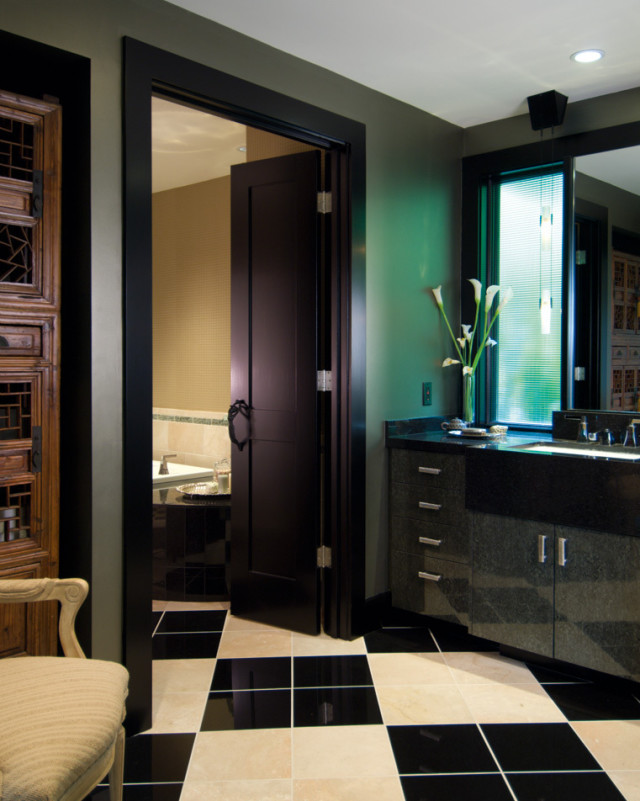
Limestone tile and lacquer cabinetry give the master bath a vintage ’20s feel.
In their global travels the Burkes have collected eclectic objects that enliven their domestic environs—including an array of decorative and ceremonial crafts from Asia and the Middle East. To wit, a colorful bridal headdress from the Sinai Peninsula hangs in the living room, and a Chinese opium bed serves as a coffee table. Some of their treasures have even been ingeniously incorporated into the home’s interior architecture: Two intricately carved wooden panels, featuring standing male and female figures, form the double doors to the master bedroom, for example; and a whimsical iron grille, picked up at a home furnishings emporium in Los Angeles, serves as a railing on the mezzanine-level corridor.
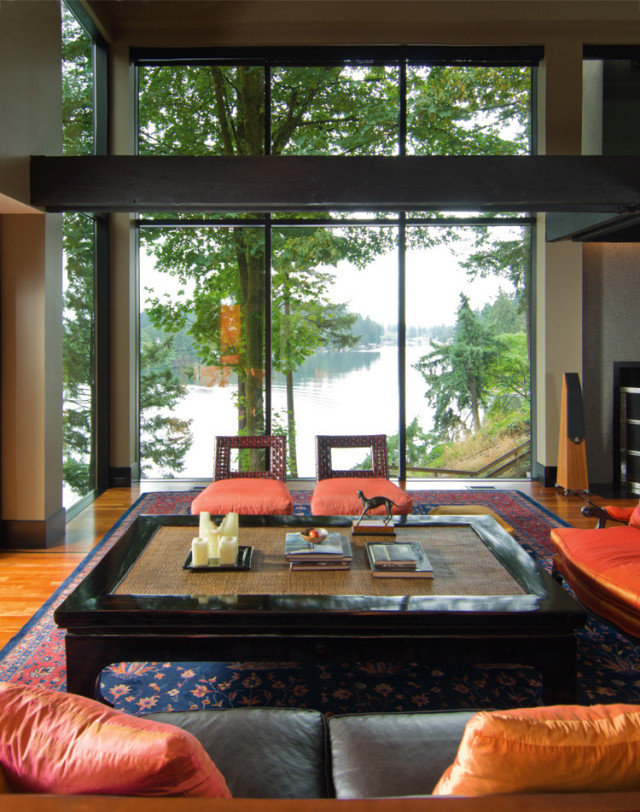
An antique opium bed offers a fitting place to set down a book and ponder a fever-dream view: On a clear day, Hood is visible through the great room’s 27-foot-high glass wall.
The Burkes are clearly enamored of their new house. “We feel like it’s a piece of art,” says Stevie. “We were out walking and a neighbor said, ‘You live in the jewel box.’ It just lights up at night. The wood floors and the interior paint throw up an amber cast.” They find themselves entertaining at home more often, she adds. “Being able to sit outside by the fireplace after dinner is fabulous.”
But the seclusion they’ve found is equally valuable. “From the lake it’s really a nondescript property,” Bob says. “Inside is our retreat.”

